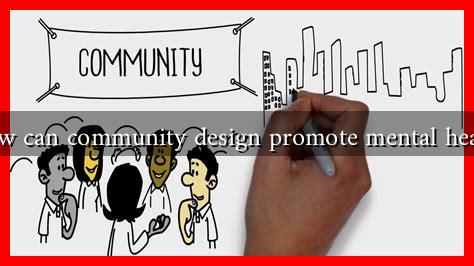-
Table of Contents
- How Can Community Design Promote Mental Health?
- The Link Between Environment and Mental Health
- Key Elements of Community Design that Promote Mental Health
- 1. Green Spaces and Nature Integration
- 2. Walkable Neighborhoods
- 3. Community Spaces for Social Interaction
- 4. Safety and Accessibility
- Case Studies: Successful Community Design Initiatives
- Conclusion
How Can Community Design Promote Mental Health?
In recent years, the connection between community design and mental health has gained significant attention from urban planners, architects, and mental health professionals alike. As urban areas continue to grow, the importance of creating environments that foster mental well-being has never been more critical. This article explores how thoughtful community design can promote mental health, highlighting key elements, examples, and strategies that can be employed to create healthier living spaces.
The Link Between Environment and Mental Health
Research has consistently shown that our surroundings can significantly impact our mental health. According to a study published in the journal Environmental Health Perspectives, individuals living in well-designed communities report lower levels of stress and anxiety. The following factors illustrate how community design influences mental health:
- Access to Green Spaces: Parks and gardens provide a natural retreat from urban life, promoting relaxation and physical activity.
- Walkability: Communities designed for walking encourage social interaction and physical exercise, both of which are beneficial for mental health.
- Social Cohesion: Well-designed neighborhoods foster connections among residents, reducing feelings of isolation.
- Safety and Security: Safe environments contribute to a sense of well-being, allowing residents to feel secure in their surroundings.
Key Elements of Community Design that Promote Mental Health
To create communities that support mental well-being, several key design elements should be considered:
1. Green Spaces and Nature Integration
Access to nature has been shown to reduce stress and improve mood. Communities that incorporate parks, community gardens, and natural landscapes can provide residents with a much-needed escape from urban stressors. For example, the High Line in New York City transformed an abandoned railway into a vibrant green space, attracting millions of visitors and enhancing the mental well-being of the surrounding community.
2. Walkable Neighborhoods
Walkability is crucial for promoting physical activity and social interaction. Communities designed with pedestrian-friendly pathways, bike lanes, and accessible public transport encourage residents to engage with their environment and each other. A study by the Centers for Disease Control and Prevention found that walkable neighborhoods lead to increased physical activity levels, which are directly linked to improved mental health outcomes.
3. Community Spaces for Social Interaction
Designing spaces that encourage social interaction can combat loneliness and foster a sense of belonging. Community centers, plazas, and shared facilities can serve as hubs for social activities, workshops, and events. For instance, the community-driven design of the “Civic Center” in San Francisco has created a vibrant space for residents to gather, learn, and connect.
4. Safety and Accessibility
Ensuring that neighborhoods are safe and accessible is vital for mental health. Well-lit streets, visible public spaces, and accessible facilities can help residents feel secure and encourage them to engage with their community. The “Safe Routes to School” program is an excellent example of how safety measures can promote mental well-being by encouraging children to walk or bike to school.
Case Studies: Successful Community Design Initiatives
Several cities around the world have successfully implemented community design strategies that promote mental health:
- Copenhagen, Denmark: Known for its extensive cycling infrastructure, Copenhagen encourages physical activity and social interaction, contributing to the overall mental well-being of its residents.
- Melbourne, Australia: The city has invested in green spaces and community gardens, which have been shown to improve mental health outcomes among residents.
- Curitiba, Brazil: This city is renowned for its innovative public transport system and green spaces, which have significantly enhanced the quality of life for its residents.
Conclusion
Community design plays a crucial role in promoting mental health by creating environments that foster social interaction, physical activity, and access to nature. By prioritizing elements such as green spaces, walkability, and safety, urban planners and community leaders can significantly enhance the mental well-being of residents. As we continue to face the challenges of urbanization, it is essential to recognize the profound impact that thoughtful community design can have on mental health. Investing in our communities is not just about aesthetics; it is about creating healthier, happier, and more connected societies.

